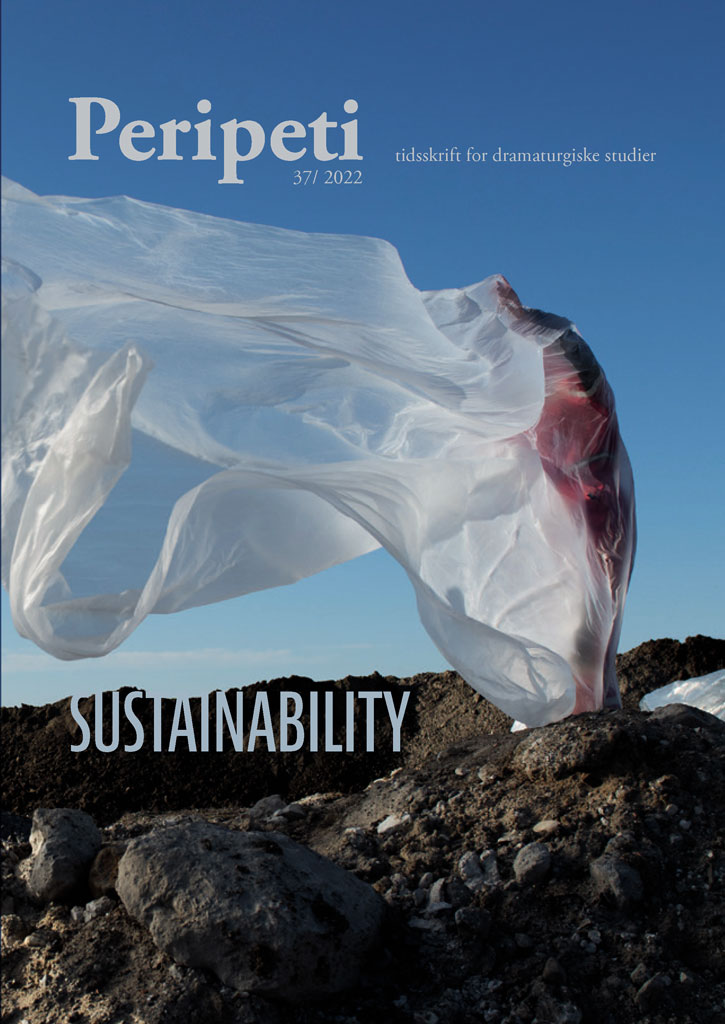Seeking Performance Sustainability within Disability
DOI:
https://doi.org/10.7146/peri.v19i37.135193Resumé
The disability community has traditionally been left out of sustainability conversations. Disability is often seen as a “blind spot” in such frameworks (Miethlich 2019) and is not considered part of sustainability metrics (Beyond Green,2019). Therefore, it is pertinent to investigate what sustainability can manifest within the institutional and aesthetic circumstances of disability arts, specifically through the lens of disabled artists across performative disciplines.
Referencer
Bruno, C. (2022) Zoom interview with Molly Joyce, 7 March.
Hehir, T., 2002. Eliminating Ableism in Education. Harvard Educational Review, 72(1), pp. 1–33.
Hunter, A. (2022) Zoom interview with Molly Joyce, 3 March.
Kafer, A., 2013. Feminist, queer, crip. Bloomington: Indiana University Press.
Kataja, R., 2020. Inclusion, Don’t Forget About Us: Disabilities in Performing Arts. Harvard Political Review, (online). Available at: <https://harvardpolitics.com/disabilities-in-performing-arts> (accessed 10 April 2022).
Kupfer, R., 2020. Disabled musicians Face “SIGNIFICANT Barriers” to music EDUCATION, new study shows. EDM.com, (online). Available at: <https://edm.com/industry/uk-study-shows-barriers-for-disabled-people-music-access> (accessed 9 September 2021).
Kuppers, P., 2013. Disability and Contemporary Performance: Bodies on the Edge (Kindle iOS version). Abingdon: Routledge.
Lewis, P., 2020. Disability Discrimination Act: 1995 and now. House of Lords Library, (online) . Available at: <https://lordslibrary.parliament.uk/disability-discrimination-act-1995-and-now> (accessed 10 April 2022).
Mozgala, G. (2022) Zoom interview with Molly Joyce, 3 March.
Penty, S., 2020. Why is there a lack of disability representation in the arts?. The Boar, (online). Available at: <https://theboar.org/2020/01/disability-arts> (14 April 2022).
Sandahl, C., and Auslander, P, eds. 2005. Bodies in Commotion: Disability and Performance. Ann Arbor: University of Michigan Press.
Siebers, T., 2010. Disability Aesthetics. Ann Arbor: University of Michigan Press.
Slater, A. (2022) Zoom interview with Molly Joyce, 25 February.
Sutherland, A,. 2005. What is Disability Arts?. Disability Arts Online, (online). Available at: <https://www.disabilityartsonline.org.uk/what-is-disability-arts> (accessed 6 May 2020).
Lazard, C., 2019. Accessibility in the Arts: A Promise and a Practice. New York: Recess. Available at: <https://promiseandpractice.art> (accessed 1 May 2022).
Downloads
Publiceret
Citation/Eksport
Nummer
Sektion
Licens
Det følgende vedrører alle Peripeti-udgivelser fra 2024, nr. 39, og senere:
Peripeti er et Diamond Open Access-tidsskrift, der giver direkte open acces til publiceret indhold ud fra princippet om, at det at gøre forskning frit tilgængelig for offentligheden understøtter en større global udveksling af viden.
Forfattere skal ikke betale for indsendelse, redigering eller offentliggørelse af artikler.
Forfattere, der bidrager til Peripeti, bevarer ophavsretten til deres artikler.
Forfattere accepterer at udgive artikler under en Creative Commons CC-BY-NC 4.0-licens. Vilkårene for denne licens tillader brugere frit at kopiere og videredistribuere materialet i ethvert medie eller format og at tilpasse, transformere og bygge videre på materialet, så længe der gives passende kreditering, et link til licensen gives, og eventuelle ændringer angives. Brugere må ikke dele eller tilpasse materialet til kommercielle formål uden samtykke fra licensgiveren. Brugen af licensen må ikke på nogen måde antyde, at licensgiveren støtter tredjeparten eller dennes brug. Licensen kan ikke tilbagekaldes.
Forfattere opfordres til at lægge deres artikler ud på personlige og/eller institutionelle hjemmesider for at sikre endnu større offentlig adgang efter udgivelsen. Forfattere har ret til at arkivere deres artikler i fondes og offentlige institutioners arkiver, men Peripeti anmoder om, at forfattere bruger et direkte link til den publicerede artikel på tidsskriftets hjemmeside, når det er muligt, da Peripeti som en ikke-kommerciel, offentligt finansieret udgiver er afhængig af niveauet af brugeraktivitet på tidsskriftets hjemmeside.
Vedrørende tidligere udgivelser, indtil 2024, herunder nr. 38:
Ophavsretten deles mellem Peripeti og forfatteren/forfatterne. Tidsskriftet er et open access-tidsskrift, der giver direkte adgang til alt indhold baseret på princippet om, at det at gøre forskning frit tilgængelig for offentligheden understøtter en større global udveksling af viden. Brugere kan frit kopiere og dele materiale i ethvert medie eller format, så længe der gives passende kreditering. Enhver anden brug kræver skriftligt samtykke fra indehaverne af ophavsretten.





